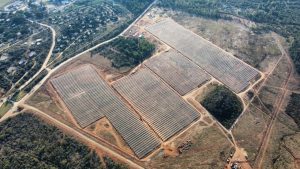

An El Niño-induced drought has contributed to lower water levels in the Kariba reservoir, while outdated equipment at Hwange frequently breaks down, reducing the country’s overall electricity production capacity.
The southern African country ― with an electrification rate of 42 percent ― is experiencing its worst power crisis on record with businesses and households having to endure lengthy power blackouts.
Faced with the bleak prospects of production outages, a number of Zimbabwean miners have adopted renewable energy sources to survive the debilitating power crisis.
Zimbabwe mainly relies on hydro and thermal energy sources but because of low water levels, obsolete equipment and infrastructure, and inability to attract significant private sector investment, power generation is only half of peak demand of 2 200 megawatts (MW).

Caledonia Mining Corporation’s 12MW solar plant.
So severe is the situation that the Chamber of Mines’s State of Mining Industry Report reported that 68 percent of miners are losing up to 20 percent of their production potential to power cuts.
The Chamber of Mines said mining companies were investing in alternative solar systems to supplement power generation.
“The Chamber continued to explore alternative power solutions for the mining industry during the period under review. To this end, the Chamber engaged Solarcentury Africa, a UK-based company, that plans to offer 60MW of electricity…and seeks potential customers while also looking for partners to develop solar plants,” the Chamber of Mines of Zimbabwe said.
In 2022, Caledonia Mining Corporation installed a 12MW solar plant, which has started generating electricity for its Blanket Mine, providing an alternative to the national grid.
Zimbabwe’s largest platinum producer, Zimplats, is building two solar power plants with a generation capacity of 185MW to power its mining operations.
Sandawana Mine has embarked on feasibility studies for the construction of a 60MW solar plant, as the company seeks to generate its own power.
RioZim, operating the Renco Gold mine, the Cam & Motor gold mine, the Dalny mine and the Empress Nickel Refinery, was granted a license to install a 75MW solar power plant that will supply power at four of its mines.
Gweru-based ferrochrome processor Zimbabwe Alloys Limited is working on developing a 15MW solar plant at its factory to alleviate the impact of power outages on its operations.
Karo Platinum Holdings is building a 30MW solar at its project which is under development in Mashonaland West province.
Padenga’s Dallaglio is constructing a state-of-the-art 7MW solar power plant at the Eureka Gold Mine in Guruve.
Energy company Grid Africa has agreed to a deal with a group of miners in Zimbabwe to build 72MW of solar for their operations.
Ferrochrome miners, the nation’s biggest electricity consumers, have agreed to build their own power plants over the next two years.
“Ferrochrome companies will be investing in renewable energy – solar and wind – commencing this year. In total, smelting companies have reached an advanced stage for construction of a total of 300 MW of solar and 100 MW of wind power,” Zesa executive chairman Sydney Gata said.
Deputy Minister of Mines Polite Kambamura said mining companies needed to adopt sustainable practices to reduce Zimbabwe’s carbon footprint including implementing renewable energy solutions.
Zimbabwe’s mining industry, a major contributor to its economy, is heavily energy-intensive. Through adopting renewable energy, the sector can reduce its reliance on fossil fuels, lower operating costs, and improve its environmental footprint.
Permanent Secretary in the Ministry of Energy, Gloria Magombo, said investments in renewable energy projects will go a long way in ensuring energy self-sufficiency.
“Zimbabwe’s economy is growing with the expectation to construct mines and heavy industries in the near future. Investment in the energy sector especially renewable will assist in powering the envisaged upper middle income economy. The importation of power from other countries is costly and usually results in higher tariffs which affects our economy,” she said at the launch of the Renewable Energy Fund.
This comes as the Ministry of Energy expects power demand to surge to 3 000 MW by 2026, with the bulk of the electricity being consumed by mining companies.
The southern African nation currently generates about 1 400 MW to 1 500 MW of power, with any shortfall plugged by imports from South Africa and Mozambique.
According to the World Bank, Zimbabwe requires a US$4,4 billion grid expansion by 2030 amid concerns that the country is losing 6,1 percent of gross domestic product (GDP) per year to power shortages.
The Bretton Woods institution says electricity demand will grow from 1 950 MW in 2022 to 5 177 MW by 2030, driven primarily by growing demand from the mining and agriculture sectors, resulting in a considerable widening of the power deficits.